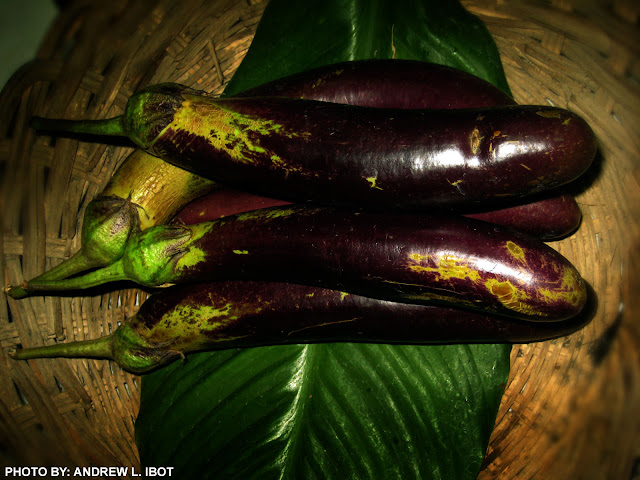Scientific name: Solanum melongena L.
English: Eggplant
Tagalog: talong
Talong is cultivated throughout the Philippines, and is common on Mt. Banahaw. In the Philippines, the Talong roots are taken as a decoction internally as an antiasthmatic and general stimulant. The roots are also used in treatment of skin diseases.English: Eggplant
Tagalog: talong
Botany
A coarse, branched, prickly or unarmed, erect, half-woody plant, growing to a height of 0.5 to 1 meter. Leaves are ovate to oblong-ovate, 10-25 cm long, hairy beneath, with shallowly lobed margins. Flowers are axillary, purplish, about 2.5 cm long. Fruit is fleshy, smooth, purple, up to 25 cm long, variable in shape, round, oblong, or cylindric-oblong.
Distribution
Cultivated throughout the Philippines for the edible fruit; the elongated variety, the most cultivated.
Constituents and properties
- Fruit contains trigonelline; choline; vitamins A. B, and C; fat, 01%; and protein, 2.2 %.
- Phytochemical studies have yielded flavonoids, alkaloids, tannins and steroids.
- Study isolated stigmasterol 1, stigmasterol-ß-D-glucoside 2, ß-sitosterol-ß-D-glucoside 3, dioscin 4, protodioscin 5 and methly protodioscin 6.
Fruits, roots.
Uses:
Nutritional
- Fruit is an excellent vegetable and popular in the rural day-to-day cuisine.
- A good source of vitamins A, B, and C.
- A good source of calcium, phosphorus, and iron; carbohydrates and fiber.
- Decoction of roots taken internally for asthma and as a general stimulant.
- Leaves are used for piles.
- The boiled root of the wild plant, mixed with sour milk and grain porridge has been used for the treatment of syphilis.
- Decoction of roots, dried stalk, and leaves is used for washing sores, exudative surfaces.
- The juice of leaves used for throat and stomach troubles.
- The fruit, bruised with vinegar, is used as a poultice for abscesses and cracked nipples.
- In Taiwan folk medicine, roots are used for rheumatism, inflammation and foot pain.
- In India, juice of various plant parts and pulp of fruits of S. melongena and its wild allies used for various ailments: diabetges, otitis, toothaches, cholera, bronchitis, asthma, dysuria, among many others.
• Hypocholesterolemic: (1) Study on human volunteers showed that S. melongena infusion showed a significant reduction of the blood levels of total and LDL cholesterol and apolipoprotein B. (2) Study of New Zealand hypercholesterolemic white rabbits fed with diets supplemented with SM fruits showed significant reduction of TC, triglycerides, and LDL, with a 24.7% increase in HDL cholesterol. The strong hypolipidemic effect with the improved HDL/LDL ratio suggests a potential benefit for its use in the treatment of hyperlipidemic-associated ischemic heart disease and arteriosclerosis.
• Bronchospasmogenic: Methanol extract of fresh leaves of SM exerted a bronchospasmogenic rather than a bronchospasmolytic effect, probably through muscarinic receptor stimulation.
• Bone Marrow Protection: Study showed animals treated with both SM extract and Doxorubicin, a potent antitumor drug, developed significantly fewer micronucleus assay and chromosomal aberrations than those treated with DXR alone. SM are rich in flavonoids with antioxidant activities.
• Antipyretic / Analgesic : Study showed the dry residue of fresh juice produced significant antipyretic (dose-dependent) and analgesic effect. The results support its use in traditional medicine.
• Analgesic : Study of hydroalcoholic extract on formalin injection-induced pain showed an analgesic effect not significantly different from that of 4 mg/kg of morphine sulfate
• Hypotensive: Study of SM extract on normotensive rats showed dose-dependent hypotensive responses possibly through its influence on the renin-angiotensive system and SME-induced diuresis. It suggests SME could be a potent hypotensive agent.
• Visual Benefits / Glaucoma : Study showed that Solanum melongena may be of benefit for patients suffering from raised intraocular pressure (glaucoma) and convergence insufficiency.
• Phytochemicals / Xanthine Oxidase Inhibition: Study yielded stigmasterol, stigmasterol-ß-D-gluvoside, dioscin, protodioscin and methyl protodioscin. The that phytosterols 1, 2 and 3 that showed strong inhibition of xantine oxidase.
• Antifungal: Different extracts of S melongena leaf were evaluated against three human pathogenic dermatophytes (Tricophyton mentagrophytes, T rubrum and T tonsurans) and two opportunistic fungi (C albicans T beigelli). Except for the water extract, all extracts showed significant antifungal property.
• Birth Control: Plant and allies yield glucoalkaloids (solasodine) that are under investigation as oral contraceptive for birth control.
Availability
Cultivated for its edible fruit.




No comments:
Post a Comment